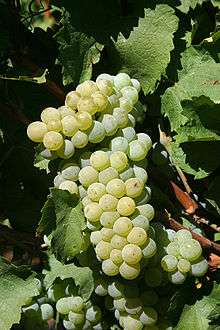
Elbling
Not to be confused with Elbing, a city in Poland.
Elbling is a variety of white grape (sp. Vitis vinifera) which today is primarily grown in the upstream parts of the Mosel region in Germany and in Luxembourg, where the river is called Moselle. The variety has a long history, and used to cover much of Germany's vineyards from medieval times and was that country's most cultivated variety until the early 20th century, but has been in decline ever since. As of 2006, there were 583 hectares (1,440 acres) of Elbling vineyards in Germany, which made it the country's 23rd most grown variety of grape. Of that vineyard surface, 575 ha or 98.6% was found in the Mosel region In the same year, there were 122.9 hectares (304 acres) of Elbling grown in Luxembourg.
History and origin
It has been speculated that Elbling was grown along Mosel already in Roman times, and that it could even be identical to the Vitis albuelis described by Lucius Columella in his De re rustica and the Vitis alba described by Pliny the Elder, although this has by no means been proven. Both Latin names mean "the white grape" and would then have been corrupted to Elbling at some later stage. DNA profiling has indicated that Elbling is an offspring of Gouais blanc (also known as Heunisch) and a cross between Traminer and some unidentified variety. This parentage is consistent with Elbling being an ancient grape variety, and incidentally, it is the same parentage as for Riesling. This parentage and history makes it likely that Elbling originated somewhere in the Rhine area.
Gros
Gros or Le Gros may refer to:
People

Gros (coinage)
A gros was a type of silver coinage of France from the time of Saint Louis. There were gros tournois and gros parisis. The gros was sub-divided in half gros and quarter gros. The original gros created by St Louis weighed about 4.52 g of nearly pure silver, and was valued at one sou, that is 12 deniers or 1/20 of a livre tournois. Unlike the gold écu that was minted in small numbers, mostly for prestige reasons, the gros was a very common coin, and very widely copied by non royal mints.
Notes

General Register Office for Scotland
The General Register Office for Scotland (GROS) (Scottish Gaelic: Oifis Choitcheann a' Chlàraidh na h-Alba) was a non-ministerial directorate of the Scottish Government that administered the registration of births, deaths, marriages, divorces and adoptions in Scotland. It was also responsible for the statutes relating to the formalities of marriage and conduct of civil marriage in Scotland. It administered the census of Scotland's population every ten years. It also kept the Scottish National Health Service Central Register. On 1 April 2011 it was merged with the National Archives of Scotland to form National Records of Scotland. All the former department's functions continue as part of the new body.
History
Initially ministers of the Church of Scotland were responsible for keeping parish records of baptisms and marriages, but only for their own church members. Later the Privy Council of Scotland, following the suggestion of the General Assembly of the Church of Scotland enacted that all parish ministers should keep a record of baptisms, burials and marriages. This situation continued until 1854, when Parliament passed an Act transferring responsibility to the State.

Grape
A grape is a fruiting berry of the deciduous woody vines of the botanical genus Vitis.
Grapes can be eaten raw or they can be used for making wine, jam, juice, jelly, grape seed extract, raisins, vinegar, and grape seed oil. Grapes are a non-climacteric type of fruit, generally occurring in clusters.
History
The cultivation of the domesticated grape began 6,000–8,000 years ago in the Near East.Yeast, one of the earliest domesticated microorganisms, occurs naturally on the skins of grapes, leading to the innovation of alcoholic drinks such as wine. The earliest archeological evidence for a dominant position of wine-making in human culture dates from 8,000 years ago in Georgia. The oldest winery was found in Armenia, dating to around 4000 BC. By the 9th century AD the city of Shiraz was known to produce some of the finest wines in the Middle East. Thus it has been proposed that Syrah red wine is named after Shiraz, a city in Persia where the grape was used to make Shirazi wine. Ancient Egyptian hieroglyphics record the cultivation of purple grapes, and history attests to the ancient Greeks, Phoenicians, and Romans growing purple grapes for both eating and wine production. The growing of grapes would later spread to other regions in Europe, as well as North Africa, and eventually in North America.
Shades of violet
There are numerous variations of the color violet, a sampling of which are shown below.
Variations of the color violet
Variations of spectral violet
Although pure spectrum violet is outside the color gamut of the RGB color space, the three colors displayed below are rough approximations of the range of colors of actual spectral violet, although the accuracy of the approximation can vary depending on the individual's color vision, and on the color rendition of one's computer monitor.
Color wheel violet
The tertiary color on the HSV color wheel (also known as the RGB color wheel) precisely halfway between blue and magenta is called color wheel violet. This tone of violet—an approximation of the color violet at about 417 nanometers as plotted on the CIE chromaticity diagram—is shown at right. This tone of violet is actually somewhat toward indigo assuming indigo is accepted as a separate spectrum color, usually quoted as having a range of from about 420 to 450 nanometers. Another name for this color is near violet.
Grape (disambiguation)
A grape is a fruit that grows on the vines of plants in the genus Vitis.
Grape may also refer to:
See also
Podcasts:

